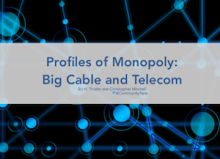Predictions for 2019, Year in Review for 2018 - Community Broadband Bits Podcast 337

We left our crystal ball, tarot cards, and astrology charts at home, but that won’t stop us from trying to predict what will happen in 2019 for this week’s annual predictions podcast. Each year, we reflect on the important events related to publicly owned broadband networks and local connectivity that occurred during the year and share our impressions for what we expect to see in the next twelve months. As usual, the discussion is spirited and revealing.
This year we saw the departures of Research Associate Hannah Trostle and Communications Manager Nick Stumo-Langer as both decided to head off to grad school. This year, you’ll hear our new Communications Specialist Jess Del Fiacco and Research Associate Katie Kienbaum keeping those seats warm. Hannah and Nick take time out of their schedules to offer some predictions of their own at the end of the show.
In addition to recaps of last year's predictions for state legislation, cooperative efforts, and preemption, we get into our expectations for what we expect to see from large, national incumbent ISPs, local private and member owned providers, and governments. We discuss federal funding, local organizing efforts and issues that drive them, concentration of power, our predictions for digital equity, efforts in big cities, open access, rural initiatives, and more. This podcast is packed with good stuff!
This show is 45 minutes long and can be played on this page or via Apple Podcasts or the tool of your choice using this feed.
Transcript below.
We want your feedback and suggestions for the show-please e-mail us or leave a comment below.
Listen to other episodes here or view all episodes in our index. See other podcasts from the Institute for Local Self-Reliance here.
Thanks to Arne Huseby for the music. The song is Warm Duck Shuffle and is licensed under a Creative Commons Attribution (3.0) license.


